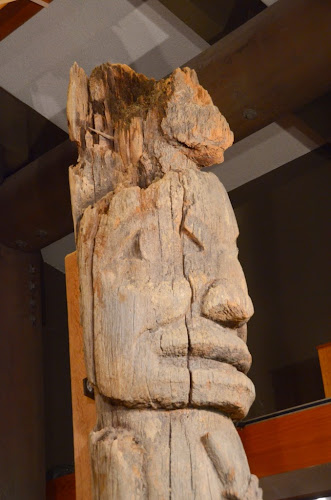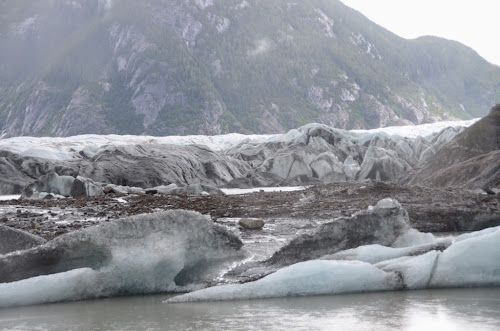Descending from the skies in brilliant sunshine with the Mendenhall Glacier to our left, into the tiny airport and out again in no time to a much higher temperature than we had expected for Alaska. Much to Mike's amusement, our driver offering us half a dozen Palinesque "You betchas" as we loaded cases and backpacks before we even got into his cab. He was then extremely eager to talk up his native city as the best place on earth, whilst warning us of the severe dangers of death by jaywalking, criticism of fellow motorists who passed us as "Californians who regard speed limits as mere suggestions", and at the same time answering the radio and his cellphone and juggling a strange assortment of different coloured numbered discs on a magnetic board mounted on his sun visor. Some sort of pre-digital video game? No he explained, he was the coordinator for his cab company and was keeping track of where the various cars were in relation to calls coming in.

From his running commentary / sales pitch, we got used to sentences starting with Juneau, as in ...... D'youknow that this is the largest city by area in the US? D'youknow that bears can often be seen strolling in the centre of downtown?
Despite his comments on the vast square mileage of the city area, we subsequently discovered that by ambling sedately in any direction we ran out of any sort of cityscape within minutes. D'youknow, this place is tiny? And regardless of his account of how dangerous it could be to cross streets at other than crosswalks with lights, we ambled leisurely at will with hardly a vehicle in sight.
Our first impressions of the town as we emerged from our hotel and walked towards the Mount Roberts Tramway was the collection of three absolutely humongous cruise ships moored on the dock front which almost equalled the width of the city from one side to the other.
Up the mountain by cable car we soared for lunch at the top, followed by a short hike above the tree line as far as the snow would let us go. Two eagles were cruising around on the air currents overhead. Many other people were dressed as we were in boots and hiking gear, but many others obviously 'cruise people' were walking the trail weighed down by huge plastic bags of whatever they had looted from downtown shops before waddling to the tram.


Back at the hotel I read the Guest Directory in search of restaurant possibilities for dinner. As they have their own dining room they must have deemed it in their favor to leave out a restaurant list. However they had enclosed a four page guide of instructions in case of fire. It started with, "It probably won't happen." Followed by, "your chances of being involved in a fire here may be a thousand to one." And I cannot leave out the concluding paragraph. "If you never have a bad experience with fire, there could be several reasons why. Maybe it's because the building is extremely well constructed to guard against the outbreak of fire. Or maybe you and all of it's other occupants have been careful not to smoke in bed or to empty ashtrays into the wastebaskets. Or maybe it's because you have understood this information. We sincerely hope you have."

On our own we found a lovely little local bistro with a table by the window. Beet salad with potato and smoked salmon and delicious fish entrees. Across the street was a ever changing group of about a dozen young men evenly spaced leaning against the building. Everyone was in possession of a phone or computer, most wearing a headset. They were all cruise ship employees piggybacking off the restaurant's free wifi without purchasing even a cup of coffee. Their curfew must have arrived when they all disappeared en masse.
It seems that we forgot to mention the stunning views of mountains, snow, and crystal clear blue skies. Aside from the cruise ships the downtown still has the feel of a frontier town. The afternoon was shirt sleeve and shorts weather prompting all of the locals to complain that it is too hot!













































